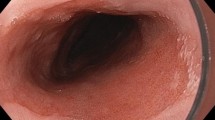Abstract
Although endoscopy is a sophisticated technique for evaluating patients with gastroesophageal reflux disease (GERD), the single diagnostic test that enables the most comprehensive assessment for GERD is a well-performed video esophagram. Not only does the barium study permit assessment of morphologic abnormalities in the pharynx and esophagus, but also oropharyngeal swallowing function, esophageal motility, and gastroesophageal reflux. These factors are especially important for detection of anatomic findings such as strictures and hernias, for assessment of esophageal motility before and after fundoplication, and for excluding conditions that mimic GERD. Thus, esophagography and esophagoscopy are complementary procedures that provide a more comprehensive and therapeutically actionable plan for patients with GERD than either diagnostic test alone.
Similar content being viewed by others
References
El-Serag HB, Sonnenberg A (1997) Associations between different forms of gastro-oesophageal reflux disease. Gut 41:594–599
Podboy A, Katzka DA, Enders F, et al. (2016) Oesophageal narrowing on barium oesophagram is more common in adult patients with eosinophilic oesophagitis than PPI-responsive oesophageal eosinophilia. Aliment Pharmacol Ther 43:1168–1177
Ott DJ, Chen YM, Wu WC, Gelfand DW, Munitz HA (1986) Radiographic and endoscopic sensitivity in detecting lower esophageal mucosal ring. AJR Am J Roentgenol 147:261–265
Ott DJ, Kelley TF, Chen MY, Gelfand DW, Wu WC (1991) Use of a marshmallow bolus for evaluating lower esophageal mucosal rings. Am J Gastroenterol 86:817–820
Somers S, Stevenson GW, Thompson G (1986) Comparison of endoscopy and barium swallow with marshmallow in dysphagia. Can Assoc Radiol J 37:73–75
Jones MP, Sloan SS, Rabine JC, et al. (2001) Hiatal hernia size is the dominant determinant of esophagitis presence and severity in gastroesophageal reflux disease. Am J Gastroenterol 96:1711–1717
Kahrilas PJ, Dodds WJ, Hogan WJ, et al. (1986) Esophageal peristaltic dysfunction in peptic esophagitis. Gastroenterology 1991:897–904
Kahrilas PJ, Dodds WJ, Hogan WJ (1988) Effect of peristaltic dysfunction on esophageal volume clearance. Gastroenterology 94:73–80
Fiorentino E, Matranga D, Pantuso G, et al. (2010) Accuracy of the water-siphon test associated to barium study in a high prevalence gastro-oesophageal reflux disease population: a novel statistical approach. J Eval Clin Pract 16:550–555
Pan JJ, Levine MS, Redfern RO, et al. (2003) Gastroesophageal reflux: comparison of barium studies with 24 h pH monitoring. Eur J Radiol 47:149–153
Davis CS, Baldea A, Johns JR, Joehl RJ, Fisichella PM (2010) The evolution and long-term results of laparoscopic antireflux surgery for the treatment of gastroesophageal reflux disease. JSLS 14:332–341
Wehrli NE, Levine MS, Rubesin SE, Katzka DA, Laufer I (2007) Secondary achalasia and other esophageal motility disorders after laparoscopic Nissen fundoplication for gastroesophageal reflux disease. AJR Am J Roentgenol 189:1464–1468
Blam ME, Delfyett W, Levine MS, Metz DC, Katzka DA (2002) Achalasia: a disease of varied and subtle symptoms that do not correlate with radiographic findings. Am J Gastroenterol 97:1916–1923
Spechler SJ, Souza RF, Rosenberg SJ, Ruben RA, Goyal RK (1995) Heartburn in patients with achalasia. Gut 37:305–308
Tucker E, Knowles K, Wright J, Fox MR (2013) Rumination variations: aetiology and classification of abnormal behavioural responses to digestive symptoms based on high-resolution manometry studies. Aliment Pharmacol Ther 37:263–274
Author information
Authors and Affiliations
Corresponding author
Ethics declarations
Conflict of interest
Dr. Katzka has no conflicts of interest to report.
Rights and permissions
About this article
Cite this article
Katzka, D.A. A gastroenterologist’s perspective on the role of barium esophagography in gastroesophageal reflux disease. Abdom Radiol 43, 1319–1322 (2018). https://doi.org/10.1007/s00261-017-1352-8
Published:
Issue Date:
DOI: https://doi.org/10.1007/s00261-017-1352-8




